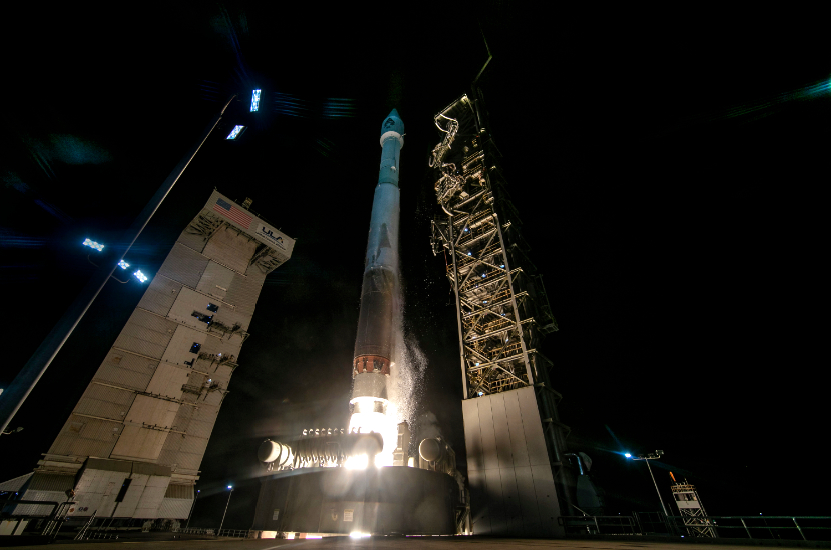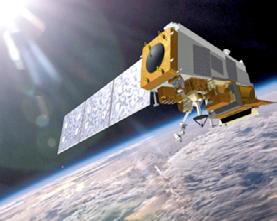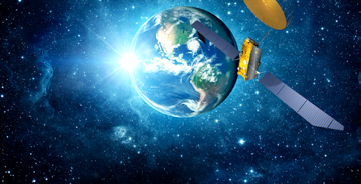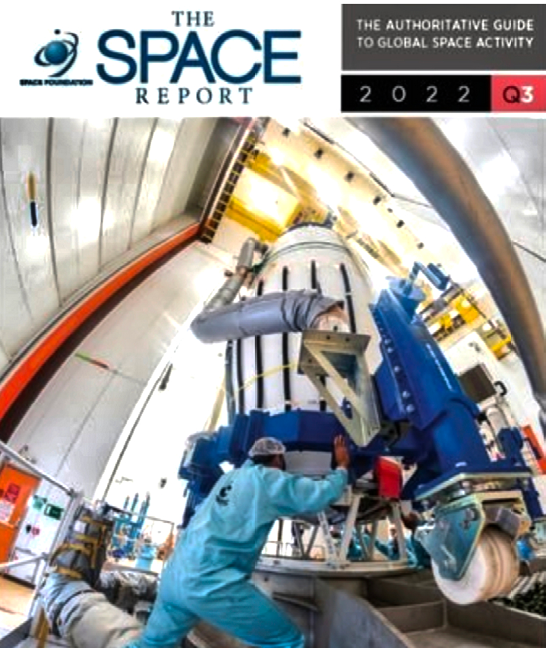ULA’s Atlas V launch vehicle lofts NOAA’s/NASA’s JPSS-2 satellite to orbit
A United Launch Alliance (ULA) Atlas V rocket carrying the Joint Polar Satellite System (JPSS)-2 mission for the National Oceanic and Atmospheric Administration (NOAA) and National Aeronautics and Space Administration (NASA) and NASA’s Low-Earth Orbit Flight Test of an Inflatable Decelerator (LOFTID) lifted off on November 10 at 1:49 a.m., PST, from Space Launch Complex-3 at Vandenberg Space Force Base.

ULA’s launch of the JPSS-2 satellite for NOAA and NASA.
Photo is courtesy of ULA.
To date, ULA has launched 155 times with 100 percent mission success.
The Atlas V rocket delivered the JPSS-2 spacecraft to sun-synchronous LEO. After delivering the JPSS-2 spacecraft, subsequent burns by the Centaur upper stage lowered the altitude to a re-entry trajectory to deploy the LOFTID experiment.
Once separated, LOFTID reentered Earth’s atmosphere, deployed its parachute and landed off the coast of Hawaii. This experiment demonstrates how an inflatable aeroshell, or heat shield, could deliver heavy payloads safely through the atmosphere to the surface of Earth and potentially other planets.
“We depend on accuracy and timeliness of weather prediction models for enhanced weather forecasting and climate observations. Our ULA team is proud to launch the JPSS-2 mission that supports advanced forecasting of extreme weather and global climate monitoring,” said Gary Wentz, ULA vice president of Government and Commercial Programs. “Additionally, we look forward to reviewing the data collected from LOFTID as we explore Hypersonic Inflatable Aerodynamic Decelerator (HIAD) technology for engine reusability on our future Vulcan rocket. Successfully deploying these two payloads is a monumental achievement; thank you to our mission partners for their outstanding teamwork.”

Artistic rendition of the JPSS-2 satellite on-orbit.
“The NASA and ULA public-private LOFTID partnership was the ideal pairing opportunity for demonstrating our Vulcan reuse plans,” said Mark Peller, ULA vice president of Major Development.
“This demonstration allows ULA to focus on launch integration applications for engine recovery including parachute development, transportation and recovery, flight environments, precision navigation for landing and recovery and more.”
Leveraging a legacy of 100 percent mission success launching more than 150 missions to explore, protect and enhance our world, ULA is the nation’s most experienced and reliable launch service provider with world-leading reliability, schedule confidence, and mission optimization. We deliver value unmatched by any launch services company in the industry, a tireless drive to improve, and commitment to the extraordinary.
www.ulalaunch.com
Rocket Lab and Inmarsat Government to develop L-Band radio for NASA’s Communications Services Project
Rocket Lab USA, Inc. has been selected by Inmarsat Government as their partner to develop and manufacture an L-band radio in support of NASA’s Communications Services Project (CSP). CSP seeks to accelerate the development of commercial near-Earth communications services by partnering with satellite communications (SATCOM) providers.

Rocket Lab will help enable Inmarsat’s InCommand, a real-time, near-Earth telemetry, command, and control (TT&C) service for satellites in Low Earth Orbit (LEO) for the CSP with the Company’s new Frontier-L radio connecting to Inmarsat’s ELERA global L-band network in Geosynchronous Orbit (GEO).
As NASA prepares to decommission the agency’s owned and operated Tracking and Data Relay Satellite System (TDRSS) system, which has provided communication for the Hubble Space Telescope, the International Space Station, and numerous NASA’s Earth Observation (EO) satellites, the CSP aims to tap into commercial satellite communications services to ensure future NASA missions have similar reliable, secure, and high- performance space relay capabilities.
Rocket Lab’s Frontier-L radio is a transmitter that will support Inmarsat Government’s demonstrations of a variety of TT&C applications, enabled by Inmarsat’s ELERA worldwide L-band network, including Launch and Early Operations Phase (LEOP), ubiquitous command and control, real-time tasking, and contingency operations for satellites in LEO orbits.
“Rocket Lab and Inmarsat Government both share a culture of innovation, pioneering technology and delivering reliable mission success, so we’re honored to be working together to support NASA in this vital project to enable major missions of the future,” said Rocket Lab founder and CEO, Peter Beck. “We look forward to building on the strong heritage of our Frontier radios by supporting Inmarsat’s world-renowned satellite network and leading capabilities providing satcom as a service.”
Frontier-L join’s Rocket Lab’s existing line of radios including the software- defined telemetry, tracking, and command ( TT&C) S-band Frontier-S and X-band Frontier-X radios which can support near Earth and deep space missions.
Based on the Johns Hopkins University (JHU) Applied Physics Lab (APL) Frontier Radio, Frontier-L packs Deep Space Network (DSN) and other typical waveforms (SN, KSAT, SSC) into a compact package with up-screened commercial components for high reliability applications. The family of Frontier by Rocket Lab radios includes extended functionality not typically available in a low-cost radio including a coherent transponder to enable radiometric navigation methods, precision timekeeping functions, forward error correction (FEC) encoding and decoding, and a hardware based critical command decoder (CCD).
Steve Gizinski, President, Inmarsat Government, said, “Inmarsat Government has joined with major space-based industry suppliers to demonstrate the capabilities of Inmarsat’s ELERA global, reliable satellite network, including for NASA’s Communications Services Project and Rocket Lab is a key partner for us. Rocket Lab’s Frontier-L radio will leverage InCommand on the ELERA network as an important new capability for ubiquitous command and control to enhance the operation of low Earth orbit spacecraft. This will enable new communications services for industry and government alike.”
Space Foundation publishes The Space Report 2022 Q3
Space Foundation has released The Space Report 2022 Q3, which examines key global space workforce data, a recruiting bonanza for the U.S. Space Force (USSF), a technological leap to treat astronaut injuries, and a new generation of spacesuits designed to fit 99% of the world’s adults.

In a four-part analysis, the Q3 edition offers a deep look at workforce issues from 2021 employment trends in the U.S. and Europe, recent headwinds that could temporarily tighten space hiring, a look at new and unexpected faces joining the space workforce, and an examination of the USSF’s recruiting success.
The newest U.S. military branch is seeing just three of every 100 applicants donning the uniform. The 2021 data is the latest year for which annual analysis is available.
The Q3 edition continues more than a decade of reporting by The Space Report on the space workforce, focusing in this edition on 2021 workforce data from across the globe.
Ongoing growth in Europe and the United States led hiring, while Asian space firms held the line or saw slight employment declines.
The variety of talent required across the space ecosystem is highlighted with a look at workers who tell of their journeys to find jobs tied to space, including some who took unlikely paths.
Included in the Q3 edition is a discussion with Maj. Gen. Ed Thomas, who is finding few challenges in his role as the U.S. Space Force’s top recruiter.
Thomas said the service is the most difficult for new recruits to enter, with more than 18,000 applicants for about 500 posts. The Guardians who did gain entry include the largest percentage of women to enter any armed service in U.S. history.

The Space Report also examines technologies that could improve the lives of astronauts as the agency races to reach the Moon and beyond.
Advancements in biotechnologies combined with 3D printing could be a boon for injured astronauts with biobandages, a polymer containing astronauts’ own cells that promises quicker healing.
Those astronauts will also be more comfortable on spacewalks and the Moon’s surface thanks to a deal between NASA and Axiom Space.
Newly developed Axiom-owned spacesuits promise a better fit than older models along with advancements in mobility and life support. Once approved for spaceflight, the spacesuits will be available for lease to NASA and commercial companies under the agreement.
“The ongoing demands of the growing space industry show the continued need for a steady supply of talent to fill an ever-growing variety of roles,” said Space Foundation CEO, Tom Zelibor. “The good news from Space Force recruiting shows these space jobs have a growing allure for young people, pointing to a bright future across the space industry as its accomplishments inspire a new generation.”
The Space Report is the authoritative report on the global space ecosystem, covering space exploration and space- inspired industries on Earth.
Published by Space Foundation since 2006 and operating under Symposium 365 division, The Space Report is available on a subscription basis, providing policy analysts, congressional staff, investors, media, and space industry newcomers with research and insight on trends and opportunities with informative articles and quarterly reports.
Highlighting each report is an overview of the latest data available on the space economy, space infrastructure, and other key industry indicators as well as analysis of commercial, government and educational events impacting business, workforce and our daily lives.
Symposium 365, a division of Space Foundation, is the premier source for media and events in the global space ecosystem, offering authoritative news and information and venues for networking and conducting business via the world- renowned Space Symposium,
Symposium 365 Digital Platform and The Space Report. Serving commercial, government and education sectors, Symposium 365 produces signature programming —live and online — for professionals, entrepreneurs, educators and students to learn, connect and conduct business 365 days a year.
www.spacefoundation.org
Space Foundation is a nonprofit advocate organization founded in 1983, offering a gateway to information, education and collaboration for space exploration and space-inspired industries that define the global space ecosystem Driven by a partnership model, Space Foundation operates three divisions that unite the entire spectrum of stakeholders — business, government, education and local communities — through corporate membership, sponsorship, fundraising and grants.
Symposium 365 is the premier source for media and events, including the world-renowned Space Symposium and The Space Report. Center for Innovation and Education is a lifelong learning platform. Global Alliance facilitates collaboration around the world.
SpaceWERX awards 124 Orbital Prime contracts
The SpaceWERX Orbital Prime program awarded 124 Phase 1 contracts from June 15 to September 22, 2022, each with a five-month term valued at $250,000. Orbital Prime, which is the first space effort under the SpaceWERX Prime line of business, intends to invigorate the In-space Servicing, Assembly, and Manufacturing, or ISAM, market using Active Debris Remediation as a use case for the foundational technologies.

The awards, made under the Department of the Air Force’s Small Business Technology Transfer, or STTR, program, administered by AFWERX, represent the first phase of the Orbital Prime program.
“As the U.S. Space Force component of AFWERX, the SpaceWERX team chose STTR awards over its more well- known and revamped Small Business Innovative Research (SBIR) contracts to drive academic engagement alongside small business,” said Gabe Mounce, SpaceWERX deputy director.
The STTR program requires that companies partner with a research institution such as an academic institution, non-profit or Federally Funded Research and Development Center to perform concept exploration, development and maturation.
Through these awards, SpaceWERX has partnered with 92 companies and 66 research institutions across the country to explore ISAM capabilities and technologies relating to identifying, approaching and servicing an object in space. The Orbital Prime program will culminate with an on-orbit mission to demonstrate active space debris remediation, a public purpose use case intended to stimulate the market for space logistics.
From this initial phase, the STTR Phase 1 awardees will be invited to propose to a STTR Phase 2 opportunity in the early part of next year. Phase 2 will last 15 months at a maximum of $1.5 million per award. SpaceWERX also recently opened a Direct-to-Phase 2 SBIR offering under topic AFX234- DCSO1 to enable small businesses to enter the Orbital Prime program in a parallel path to the STTR Phase 2. Both paths, considered to be Phase II of the Orbital Prime program, will lead to Strategic Financing opportunities in Phase 3 of the program.
The companies receiving Phase 1 awards include:
• Acellent Technologies, Inc.
• Altius Space Machines, Inc.
• Assured Space Access Technologies, Inc.
• ASTER Labs, Inc.
• Astrobotic Technology Inc.
• Atomos Nuclear and Space Corporation
• Auxon Corporation
• BlackSky Geospatial Solutions, Inc.
• BotFactory, Inc.
• Busek Co Inc.
• Cambrian Works, Inc.
• Circle Optics, Inc.
• Continuum Space Systems, Inc.
• ControlX, Inc.
• Elevan LLC dba Elevate Systems
• Enduralock, LLC
• EPSILON3, Inc.
• First Light Observatory Systems, LLC
• Free Space Inc.
• Galactiv, Inc.
• Galois, Inc.
• GEOJUMP, Inc.
• GhostWave Inc.
• GreenSight
• GRID RASTER Inc.
• Howe Industries LLC
• Hypergiant Galactic Systems, Inc..
• iMetalx Group, LLC
• Integral & Open Systems, Inc..
• Inversion Space Company
• Kall Morris Inc.
• Karax LLC
• Kayhan Space Corp
• krtkl Inc.
• Launcher Inc.
• Lexsetai Inc.
• LGarde, Inc.
• Lunar Outpost Inc.
• Lunar Resources, Inc.
• MARS Aerospace Company
• Martian Sky Industries, LLC
• Metis Design Corporation
• Microsurgeonbot Inc.
• Motiv Space Systems
• Mountain Aerospace Research Solutions
• Nanoracks, LLC
• NearSpace Launch Inc.
• Neutron Star Systems USA LLC
• nou Systems, Inc.
• O Analytics Incorporated
• Octagon II, Inc.
• Off-World, Inc.
• Ombra LLC
• Orbital Bridge LLC
• Orbital Composites, Inc.
• Physical Sciences Inc.
• PickNik Inc.
• Plasma Controls, LLC
• Polaron Analytics
• Quidient, LLC
• Radsul Inc.
• RapidFort, Inc.
• Rhea Space Activity
• Rockdrill Research LLC
• Rogue Space Systems Corp.
• Sci Zone
• Scientific Systems Company, Inc.
• SCOUT Inc.
• Sedaro Corporation
• Senseics Ltd
• SIMBA Chain Inc.
• Slingshot Aerospace, Inc.
• Space Micro Inc.
• SpaceWorks Enterprises, Inc.
• Spectral Energies, LLC
• Starfish Space
• Tangram Flex, Inc.
• Target Arm Inc.
• Ten One Aerospace LLC
• ThinkOrbital Inc.
• Toyon Research Corp
• Traclabs, Inc.
• Traction Jedi Technologies, LLC
• TrustPoint, Inc.
• Turion Space Corp
• Vision Systems Inc.
• VisSidus Technologies, Inc.
• Vy Corporation
• Wallaroo Labs, Inc.
• Weintraus, Inc. DBA Modularity Space
• Xtensor Systems Inc.
• Ziuli Holdings LLC
The Phase 1 research institution partners Include:
• Air Force Institute of Technology (AFIT)
• Arizona State University
• Boston University
• Brigham Young University
• Brookhaven National Laboratory
• California State University Northridge
• Carthage College
• Catalyst Campus for Technology and Innovation
• Clarkson University
• Colorado State University
• Cornell University
• Draper Laboratories
• Eastern Michigan University
• Embry-Riddle Aeronautical University
• Expanding Frontiers
• Florida Institute of Technology
• Georgia Institute of Technology
• Illinois Institute of Technology
• Johns Hopkins University
• Johns Hopkins University Applied Physics Laboratory
• Louisiana Tech University
• Massachusetts Institute of Technology LIncoln Laboratory
• Michigan Technological University & Michigan State University
• MIT Innovation Initiative
• MIT LIncoln Laboratory
• Morehead State University
• New Mexico Institute of Mining and Technology
• New Space New Mexico
• Oakland University
• Oklahoma State University
• Purdue University
• San Diego State University Research Foundation
• Sandia National Laboratories
• Southeast Innovation Institute
• Southwest Research Institute
• SRI International Computer Science Laboratory
• Stanford University
• Stevens Institute of Technology
• Taylor University
• Texas A&M Engineering Experiment Station
• The Ohio State University
• The Pennsylvania State University, Applied Research Laboratory
• The University of Alabama
• The University of Texas at Austin
• The University of Texas at Austin Office of Sponsored Projects
• Trustees of the University of Pennsylvania
• United States Naval Research Laboratory
• University of Alabama in Huntsville
• University of Central Florida
• University of CIncinnati
• University of Colorado Boulder- Office of Contracts and Grants
• University of Dayton CME Department
• University of Florida
• University of Illinois at Urbana Champaign
• University of Maryland
• University of Massachusetts Amherst
• University of New Mexico
• University of Notre Dame
• University of Southern California Information Sciences Institute
• University of Tennessee Space Institute
• University of Texas at Arlington
• University of Texas at Austin
• University of Texas at San Antonio
• University of Utah
• University of Washington
• Virginia Polytechnic Institute and State University
• Yeshiva University

